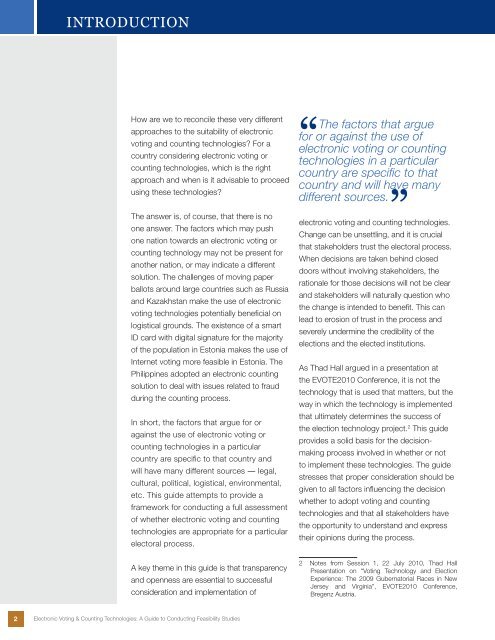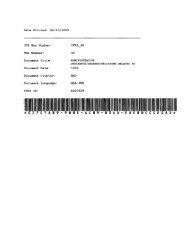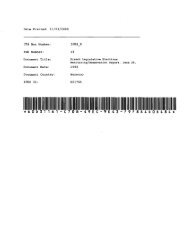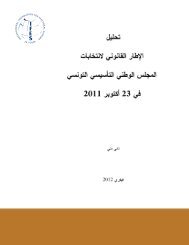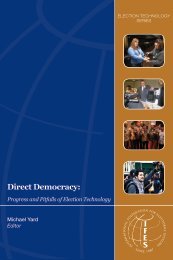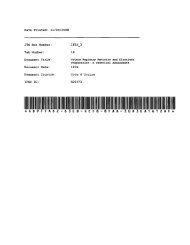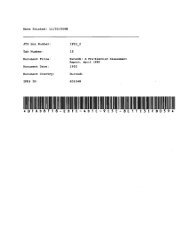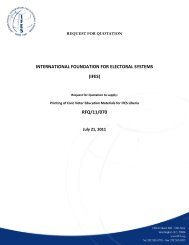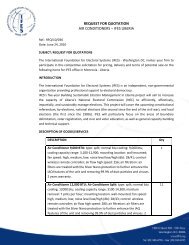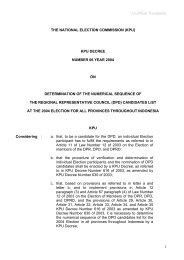Electronic Voting & Counting Technologies - IFES
Electronic Voting & Counting Technologies - IFES
Electronic Voting & Counting Technologies - IFES
- No tags were found...
Create successful ePaper yourself
Turn your PDF publications into a flip-book with our unique Google optimized e-Paper software.
INTRODUCTIONINTERNATIONAL ELECTORAL STANDARDSHow are we to reconcile these very differentapproaches to the suitability of electronicvoting and counting technologies? For acountry considering electronic voting orcounting technologies, which is the rightapproach and when is it advisable to proceedusing these technologies?The answer is, of course, that there is noone answer. The factors which may pushone nation towards an electronic voting orcounting technology may not be present foranother nation, or may indicate a differentsolution. The challenges of moving paperballots around large countries such as Russiaand Kazakhstan make the use of electronicvoting technologies potentially beneficial onlogistical grounds. The existence of a smartID card with digital signature for the majorityof the population in Estonia makes the use ofInternet voting more feasible in Estonia. ThePhilippines adopted an electronic countingsolution to deal with issues related to fraudduring the counting process.In short, the factors that argue for oragainst the use of electronic voting orcounting technologies in a particularcountry are specific to that country andwill have many different sources — legal,cultural, political, logistical, environmental,etc. This guide attempts to provide aframework for conducting a full assessmentof whether electronic voting and countingtechnologies are appropriate for a particularelectoral process.A key theme in this guide is that transparencyand openness are essential to successfulconsideration and implementation of“The factors that arguefor or against the use ofelectronic voting or countingtechnologies in a particularcountry are specific to thatcountry and will have manydifferent sources.”electronic voting and counting technologies.Change can be unsettling, and it is crucialthat stakeholders trust the electoral process.When decisions are taken behind closeddoors without involving stakeholders, therationale for those decisions will not be clearand stakeholders will naturally question whothe change is intended to benefit. This canlead to erosion of trust in the process andseverely undermine the credibility of theelections and the elected institutions.As Thad Hall argued in a presentation atthe EVOTE2010 Conference, it is not thetechnology that is used that matters, but theway in which the technology is implementedthat ultimately determines the success ofthe election technology project. 2 This guideprovides a solid basis for the decisionmakingprocess involved in whether or notto implement these technologies. The guidestresses that proper consideration should begiven to all factors influencing the decisionwhether to adopt voting and countingtechnologies and that all stakeholders havethe opportunity to understand and expresstheir opinions during the process.2 Notes from Session 1, 22 July 2010, Thad HallPresentation on “<strong>Voting</strong> Technology and ElectionExperience: The 2009 Gubernatorial Races in NewJersey and Virginia”, EVOTE2010 Conference,Bregenz Austria.2<strong>Electronic</strong> <strong>Voting</strong> & <strong>Counting</strong> <strong>Technologies</strong>: A Guide to Conducting Feasibility Studies


